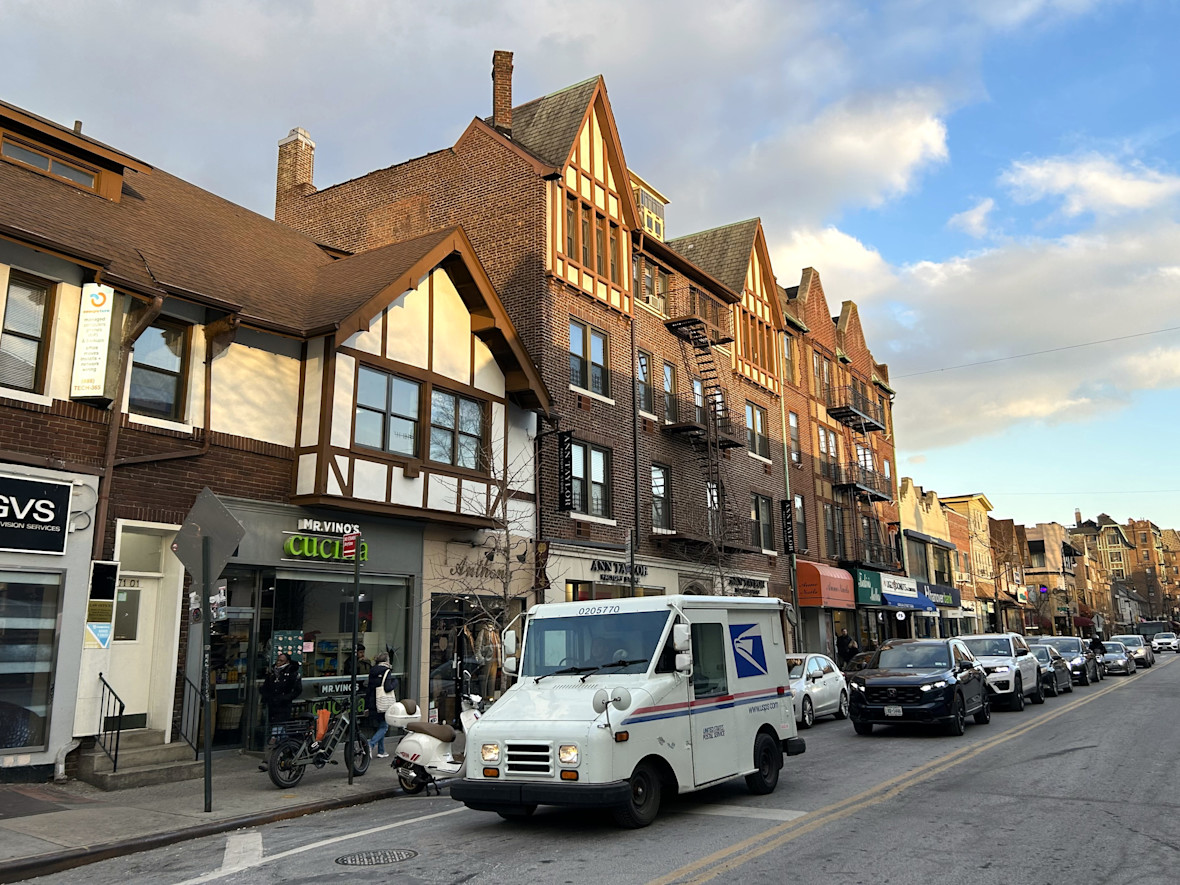It doesn’t take much to find the past in Forest Hills. Blurring the line between urban neighborhood and sleepy suburb, this portion of Queens is filled with historical remnants. Once known as Whitepot, the neighborhood was renamed in 1906, when a development company bought up 650 acres of farmland near Forest Park to turn into single-family homes. The arrival of the subway and the Long Island Rail Road over the following years spurred population growth, bringing with it businesses and busier streets, but the area has not lost its residential character.
Forest Hills is best known as the home of Forest Hills Stadium, the former site of the US Open tennis tournament and a legendary outdoor concert venue that has hosted some of the biggest musical acts since the 1960s. There’s plenty more to see and do, though, if you make the trek.
CHECK OUT FOREST HILLS' HISTORIC LANDMARKS

Two unique pieces of New York City history can be found in Forest Hills: the aforementioned Forest Hills Stadium, and Forest Hills Gardens, a planned housing community. Both played a huge part in shaping Forest Hills and its future, transforming the area from a little-known rural enclave into a desirable and upscale destination.


Built in 1923, Forest Hills Stadium was the home of the West Side Tennis Club, which had moved from Manhattan to Queens in search of more space for its members. Over the next 50 years, some of the greatest tennis players of the 20th century would take the court there: Tracy Austin, Billie Jean King, Althea Gibson, John McEnroe, Martina Navratilova. But in 1978, the US Open moved to Flushing Meadows, and the stadium gradually fell into disrepair.

Forest Hills Stadium narrowly avoided the wrecking ball and was restored in 2013 to begin its second life as a music venue. (Concerts are nothing new there, though; musicians including Bob Dylan, the Beatles, the Rolling Stones, and Frank Sinatra played the arena in the 1960s and 70s.) The West Side Tennis Club, meanwhile, is still in business, with over three dozen courts on five surfaces available to members, as well as spaces for paddle and pickleball.
Forest Hills Stadium and the West Side Tennis Club are situated within Forest Hills Gardens, a private neighborhood that's both an architectural oddity and a living time capsule. Created and developed in the 1910s, it was planned on the English garden city model, and its buildings are all in the Tudor-style, with pitched roofs, gables, timber framing, and terracotta tiling.



The brick-paved Station Square serves as the gateway to the neighborhood, linking the Forest Hills LIRR station — which was opened in 1911 and designed to fit in with its surroundings — to Forest Hills Gardens through a space that evokes the center of an English village, complete with ivy growing on the walls and a clocktower. There’s no other place like it in New York.
EXPLORE THE BEST OF FOREST HILLS' FOOD & SHOPPING SCENE

Forest Hills is a largely residential area, but its two main streets offer plenty of good shopping and dining for visitors. Take a walk down bustling Austin Street on the northern end of the neighborhood and you’ll find a mall splayed out over a dozen blocks, with national chains and small local businesses shoulder to shoulder.


You’ll also come across one of the best slices in Queens at Austin Street Pizza, where the traditional New York-style pizza is done flawlessly. You can’t go wrong with anything on the menu, but you have to try the NY 2.0, which builds on the typical New York slice by adding Parmigiano-Reggiano cheese and fresh basil, giving it an extra nuttiness and slight bit of spice to elevate a classic in a thoughtful way.

Where Austin Street Pizza is all about simplicity done right, Stacked Sandwich Shop near Yellowstone Boulevard revels in excess. Their menu is loaded with subs of all types and classics like the muffuletta and the Reuben, but the star of the show is the enormous Stacked OG, a 14-inch hero packed to the rafters with five kinds of meat, two different cheeses, and sweet and spicy peppers. The finished product weighs about as much as a newborn baby and might require you to unhinge your jaw to eat it; your reward is a sublime mix of heat, crunch and cured meat that’ll bring to mind the best Italian deli sub of your life. If you’re brave and starving, you can try to take the Stacked OG down alone, but you’re better off splitting it with two or three (or a dozen) friends.

On the south side of Forest Hills is the less hectic Metropolitan Avenue, where you can find locally owned shops that have been pulling in customers for decades. Aigner Chocolates, an Austrian-style chocolatier that’s been in business since 1930 and was family owned for three generations, makes classic artisan confections like cordials and truffles using vintage equipment. You can lose an entire day just eyeing the rows of chocolates neatly arranged in glass cases; be sure to leave with some peppermint bark or a box of caramels.


Going west on Metropolitan is another decades-old store where vintage treasures sit behind glass: Royal Collectibles. A haven for comic books fans, this family-owned and operated shop is the place to find both mainstream and indie publishers, as well as graphic novels and figurines. They’ll even set up a pull list of new releases to hold for customers. Right down the street is their sister shop, Royal Sports & Entertainment, which carries tons of sports memorabilia and gaming cards galore.



The jewel of Metropolitan Avenue, though, is Eddie’s Sweet Shop. An old school ice cream parlor and soda fountain, it’s owned and run by Vito Citrano, whose father Giuseppe bought the restaurant in 1968. Little if anything looks like it’s been changed in the time since; virtually everything inside, from the green-and-white tiled floor to the long marble bar to the tin ceiling, is original. Vintage fridges hold homemade ice cream that comes served in stemmed stainless steel bowls. Their sundaes and banana splits are picture perfect, covered in syrup and whipped cream – also made in house – and bursting with flavor. Eddie’s is an institution, and it’s a must for any trip to Forest Hills.
PAY TRIBUTE TO A FAMOUS FOREST HILLS FOURSOME

Before you leave Forest Hills, venture away from the main streets to find a small memorial to one of the neighborhood’s greatest cultural legacies. Many artists and entertainers called Forest Hills home, from Steely Dan’s Walter Becker (who has a street named for him at 72nd Drive and 112th Street) to Ray Romano to Art Garfunkel and Paul Simon, who both grew up in the neighborhood, met at the age of 11 and attended Forest Hills High School together.
Then there was the quartet of Jeffrey Hyman, John Cummings, Douglas Colvin and Thomas Erdelyi, better known to fans and history as the Ramones. Before forming one of the most influential rock bands of all time in the early 1970s, these Forest Hills natives spent their teenage days hanging out on the ramp of a parking lot in an apartment complex near 66th Road and 99th Street. Today, you can find a mural there based off a photo taken by Bob Gruen in 1975 showing the Ramones on the ramp, honoring their place in music and local history.
HOW TO GET THERE

The main subway station in Forest Hills is 71 Av-Forest Hills, served by the E, F, M and R trains, located on Queens Boulevard. This is the best stop for reaching the heart of the neighborhood and for getting to Austin Street, as well as the closest station to Forest Hills Stadium, which is a five-to-10-minute walk away. There are no subway stations on Metropolitan Avenue; to reach that road, you can walk or hire a car from the subway, or take the Q23 bus, which has a stop close to the 71 Av-Forest Hills subway station.

You can also take Long Island Rail Road to and from the Forest Hills station. (Fun historical fact: Theodore Roosevelt gave a speech from the steps of this very LIRR station on July 4, 1917.) Only trains on the Babylon Branch make stops here regularly, with the rest stopping only during peak periods; trains on the Port Jefferson, Montauk and Oyster Bay branches do not serve this station.



